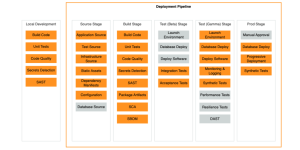
The age-old saying “Don’t put all your eggs in one basket” has found a new resonance in today’s cloud landscape. The cloud-centric world is shifting towards flexibility and choice. Businesses are increasingly opting for multi-cloud environments, leveraging the diverse strengths of multiple cloud providers as per their cloud computing and data storage needs. A recent survey by Everest Group highlighted that 78% of organizations prefer either a hybrid cloud or multi-cloud strategy to avoid vendor lock-in issues and adopt a best-of-breed approach toward workloads on the cloud.
In a multi-cloud setup, businesses don’t depend on just one cloud provider. Instead, they spread out their workloads and data across several cloud platforms. These platforms can be public clouds, private clouds, or a combination of both (hybrid clouds).
Benefits of a Multi-Cloud Strategy: More Than Just Avoiding Lock-In
While escaping vendor lock-in is a popular reason for adopting a multi-cloud strategy, it’s just the tip of the iceberg. Here are some key benefits that can unlock significant value for your organization:
- Business continuity: Spread workloads to ensure continuous availability.
- Optimized Performance: Select the best platform for each workload.
- Improved Compliance: Adhere to regulations with diverse cloud options.
- Cloud Cost Optimization: Capitalize on competitive pricing and discounts.
- Innovation: Access a variety of cloud services for best-of-breed solutions.
- Disaster Recovery: Ensure business continuity with data replication.
- Scalability and Flexibility: Easily adjust resources based on demand.
- Innovation: Access the latest cloud features and experiment with cutting-edge solutions.
- Geographical flexibility: The multi-cloud setups enable the distribution of data and applications across various regions, ensuring compliance with data sovereignty laws and enhancing performance for users globally.
However, realizing these benefits in practice can be complex. Optimizing cloud spending across multiple clouds brings with it a unique set of challenges for many organizations.
Fortunately, this challenge is manageable with the help of multi-cloud cost optimization strategies. This article explores effective strategies for your cloud cost optimization approach specifically for multi-cloud environments.
What is multi-cloud cost optimization?
Multi-cloud cost optimization means managing expenses across various cloud providers like AWS, Azure, and Google Cloud to find the best balance between cost and performance. Cloud cost optimization requires a thorough understanding of each workload’s unique requirements and performance thresholds. By utilizing a combination of tools, techniques, and best practices, businesses can increase their return on investment and maximize the value they receive from their cloud resources.
Let’s learn some of the essential strategies for effectively optimizing your cloud expenditure.
Leveraging a Centralized Cloud Cost Management Platform
Utilize a centralized cost management solution to streamline cost tracking and analysis across multiple cloud providers. This provides a unified view of costs, enables cost allocation, and facilitates analysis and cloud cost optimization.
Opt for the “right-sizing” strategy
Optimizing resource allocation is a cornerstone of cost-effective multi-cloud environments. This approach, known as right-sizing, ensures your cloud resources – computing power and storage capacity – align precisely with application needs.
Essentially, right-sizing involves identifying the sweet spot between performance and cost.
- Granular usage analysis: Deep dive into application resource utilization patterns, pinpointing peak and off-peak demands.
- Dynamic scaling: Utilize auto-scaling tools that automatically adjust resource allocation based on real-time requirements, eliminating overprovisioning and associated expenditure.
- Strategic instance selection: Explore diverse configurations offered by different cloud providers, selecting the most cost-effective options for your specific workload profile.
Remember, right-sizing is not a one-time effort. It’s an ongoing cycle of monitoring, analyzing, and adapting, ensuring cloud cost optimization without compromising performance.
Opt for Consolidated Billing in Multi-Cloud
For large enterprises navigating the complexities of multi-cloud environments, consolidated billing emerges as an effective way for cloud cost optimization and visibility. Consolidated billing can help organizations avoid the pitfalls of unexpected charges and billing discrepancies that can arise when using multiple cloud providers. By centralizing billing, companies can more easily identify errors or inaccuracies in their bills and take prompt action to resolve them.
Establishing a Culture of Cloud Financial Accountability
Cloud cost optimization cannot survive without proper financial accountability. Cloud cost governance emerges as the key to establishing control and ensuring transparency across independent teams and projects. This requires a strategic approach built on the following pillars:
- Tag, track, trace: Implement a detailed tagging system that categorizes resources by department, project, or application. This allows clear cloud cost allocation, showing exactly where expenses originate, and fostering responsibility.
- Set limits, and get alerts: Establish budgets and configure alerts to notify you when spending exceeds predefined thresholds. This proactive approach empowers teams to take corrective action before cloud costs become significant.
- Define and enforce policies: Create rules for resource management, including automated processes to identify and terminate idle or underutilized resources. This eliminates unnecessary costs and optimizes resource allocation.
Leverage spot, reserved instances, and savings plan
Managing multi-cloud costs requires a multifaceted approach. Fortunately, several cloud cost optimization strategies exist, each offering distinct advantages:
- Spot Instances: Leverage deeply discounted compute capacity for non-critical, flexible workloads.
- Reserved Instances: For predictable workloads with steady resource needs, opt for Reserved Instances. By committing to specific instances for a set period, you lock in significantly lower rates compared to on-demand pricing, ideal for mission-critical applications and stable workloads.
- Savings Plans: For broader cloud cost optimization, consider Savings Plans. Prepay for a certain amount of resource usage over a term and enjoy consistent discounts across all your cloud services, regardless of specific instance types.
Choose the plan that aligns with your overall usage patterns for predictable savings with prepayment flexibility. Remember, analyze your workloads and mix these strategies to optimize your multi-cloud cost optimization.
Optimize data transfer costs
In a hybrid cloud environment, data transfer costs can soar due to frequent movement between on-premises and cloud resources. Here are some key strategies to optimize this critical expense:
- Prioritize local processing: Analyze which data processing tasks can be performed effectively on-premises, minimizing cloud data transfers.
- Utilize Compression and Deduplication: By compressing files before transferring them, you can significantly reduce the amount of data being sent, leading to lower costs. Deduplication, on the other hand, eliminates redundant data, further reducing the overall transfer size.
- Explore alternative pricing models: Look for short-term or committed use discounts offered by cloud providers for predictable data transfer needs.
Optimize Storage cost
Similar to data transfer cost, it is extremely important to optimize storage cost. Choose the most cost-effective storage class based on performance requirements and access patterns. Cloud providers offer multiple storage classes with varying performance levels and pricing structures, allowing organizations to select the most suitable option for their needs.
Partner for Expertise
Partnering with a third-party end-to-end multi-cloud optimization partner can be a smart decision if you want to save time, effort, and money.
Not only will a third-party partner streamline your multi-cloud operations, but they can also help you identify cost-saving opportunities and optimize your infrastructure for maximum performance. By taking advantage of their expertise, you can free up your team to focus on more strategic initiatives and drive your business forward. Also, the survey suggests that over 50% of organizations expect FinOps solutions and services to expand to cover multi- and hybrid cloud environments.
Continuous cloud cost optimization
Conquering multi-cloud costs requires a commitment to continuous cloud cost optimization. Think of it as a never-ending quest, not a once-and-done task.
Remember, even the best strategies need revisiting. Periodically evaluate the effectiveness of your current plan, considering factors like evolving business needs, new cloud offerings, and internal resource changes. Don’t be afraid to retool your approach and adapt to ensure sustained cost efficiency.
The ending note
Cloud cost optimization is a journey, not a destination. To stay ahead of the curve, you need to continuously refine your cloud approach, and consider FinOps solutions for deeper insights and automation. By implementing these strategies, you can embark on a structured approach to multi-cloud cost optimization, ensuring maximum value from your cloud investments.
By Aman Aggarwal

